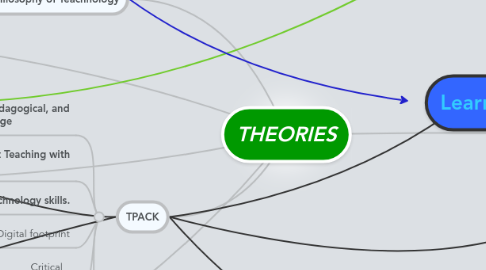
1. Media Ecology
1.1. Study of media environments.
1.2. The study of how media and communication processes affect human perception and understanding.
1.3. Technology will influence society.
1.4. Communication technology is the primary cause of social change.
1.5. Hot Media
1.5.1. High definition communication, that has little involvement from the audience.
1.6. Cold Media
1.6.1. Media that demands active involvement from the audience.
2. SCOT
2.1. Social Construction of Technology
2.2. Society and human action influences technology
2.3. Known also as Technological constructivism
2.4. METHODOLOGY
2.4.1. Formalizes steps and principles to follow to analyze the causes of technological success or failures.
3. TechnologyTheories
3.1. SCOT
3.2. Media Ecology
4. TPACK
4.1. Technological, Pedagogical, and Content Knoweldge
4.2. Teacher knowledge about Teaching with Technology.
4.3. Information, media and technology skills.
4.4. Digital footprint
4.5. Critical Thinking
4.6. Communication and collaboration.
5. Philosophy of Teachnology
5.1. Personal philosophy on how to use technology as a teaching tool.
5.2. Personal values and beliefs about teaching and learning. Personal and Educational experiences.
5.3. Why do we teach?
5.3.1. To give students tools to succeed in life.
5.3.2. To give students tools to make good decisions.
6. LearningTheories
6.1. Constructivism
6.1.1. Knowledge is contructed by the learner.
6.1.2. Creates tangible real world objects
6.1.2.1. Students construct their knowledge actively.
6.1.3. Teachers provide tools such as problem solving and inquiry based learning activites.
6.1.4. Students formulate in a collaborative learning environment.
6.1.5. Transforms student from passive to active participant.
6.2. Connectivism
6.2.1. Knowledge exists in the world, not in the brain.
6.2.2. Learning theory for "digital age"
6.2.3. Learning process of creating connection and developing a "network".
6.2.4. Knowing were to find information is more important than knowing information.
6.2.5. The Teacher is the one who guides the network.
6.2.5.1. Guidance
6.2.5.2. Communicate and ask help from experts.
6.2.5.3. Content
6.3. Cognitive Load
6.3.1. Consists of two kinds of memory; working memory and long term memory.
6.3.2. Amount of information the brain can hold and manipulate at once.
6.3.3. What we can manage at a given point in time.
6.3.4. Reducing Cogntive Load
6.3.4.1. Chunking content, using modules.
6.3.4.2. Establish simple design basics
6.3.4.3. Use white space and fonts as organizing tools.
6.3.4.4. Novice or expert learning; design different programs for different levels of learners.
6.3.4.5. Bandwidth
6.3.4.6. Visual
6.3.4.7. Auditory
